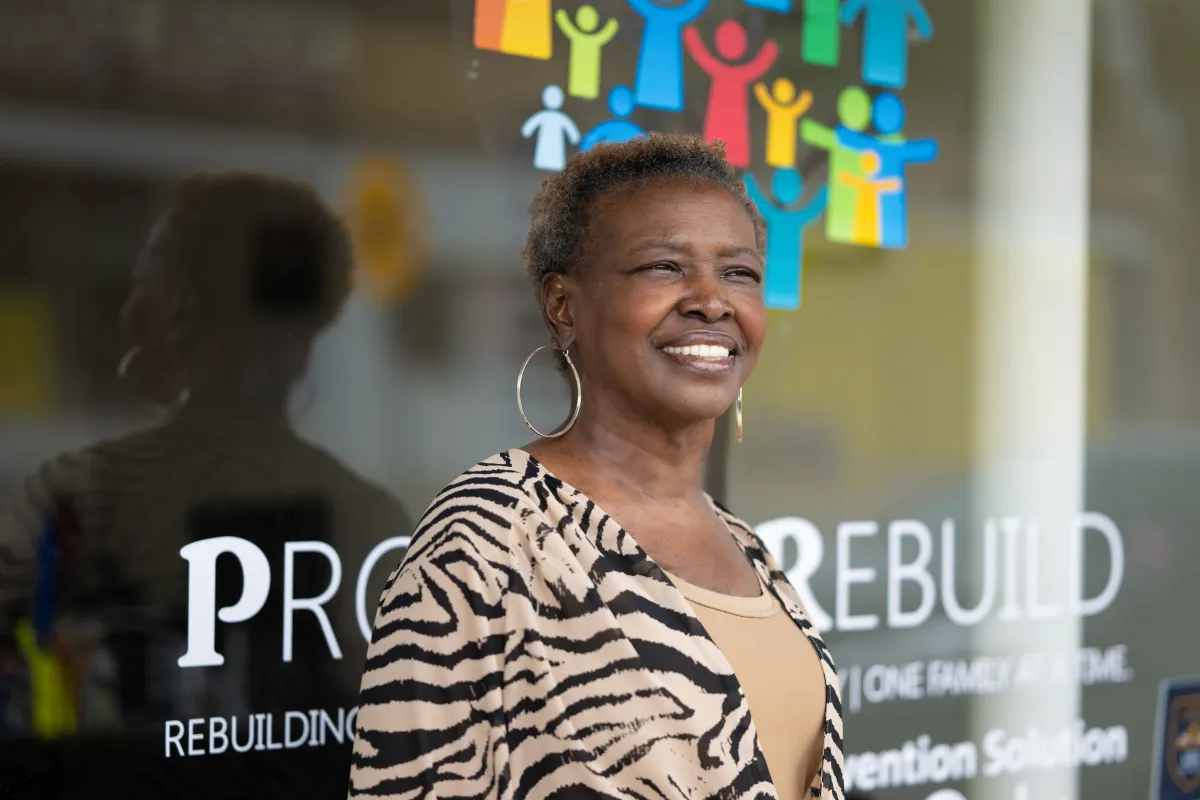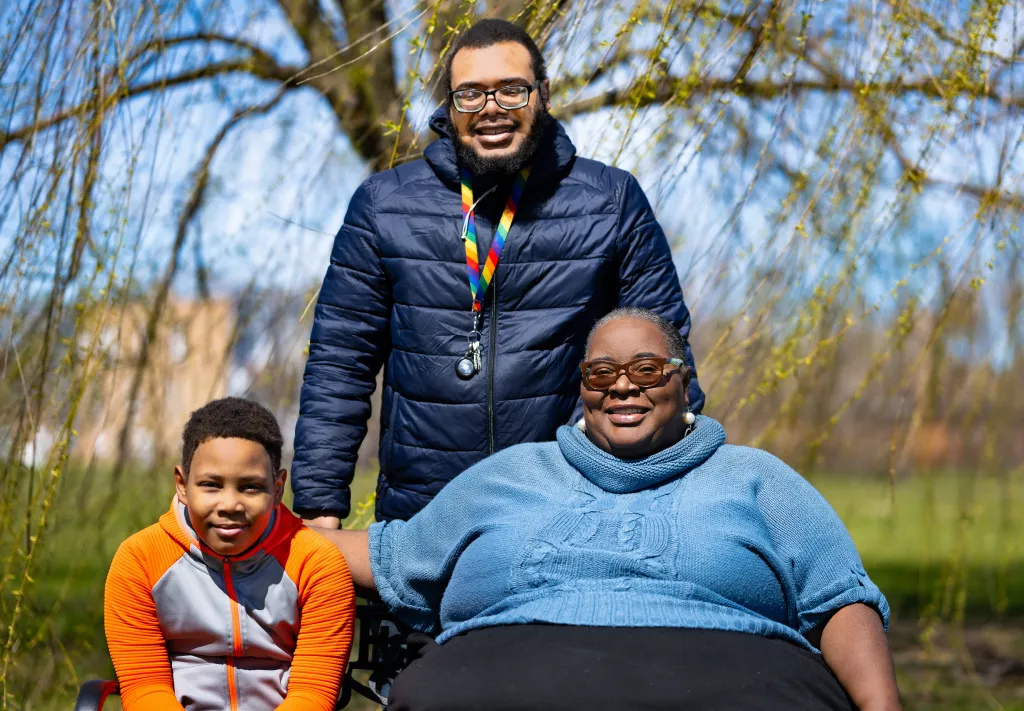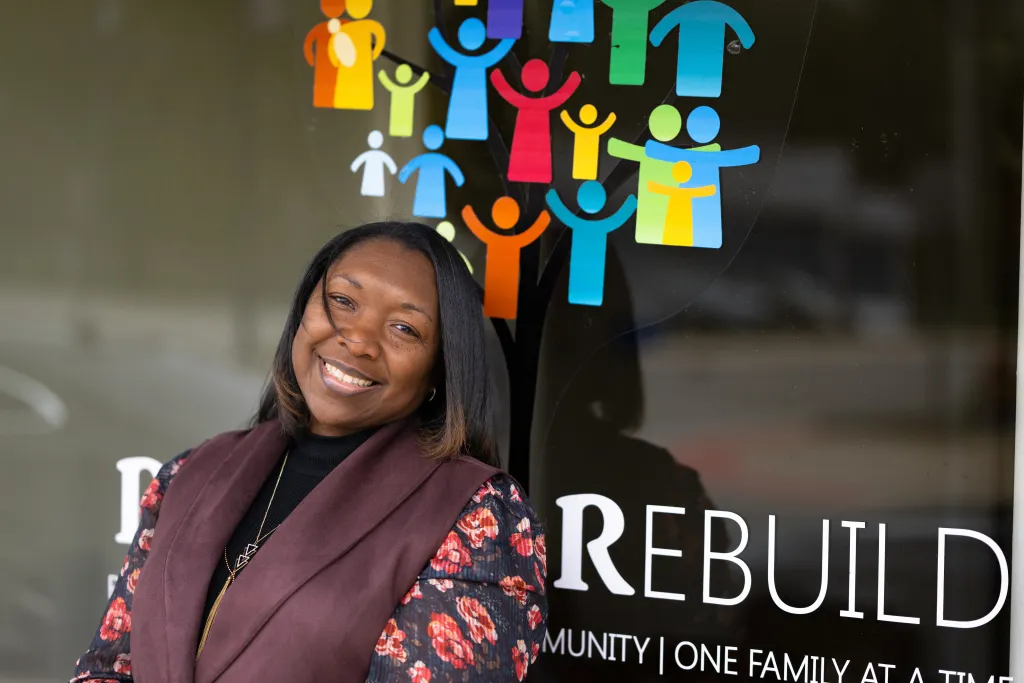




NIPSCO donates $10,000 to Project Rebuild
Source: The Crusader Newspaper

Truancy intervention and prevention program could become county-wide model
A van to provide transportation for families has become less of a dream and more of a reality for Project Rebuild now that it has received a $10,000 donation from NIPSCO.
Inga Lewis-Shannon, Project Rebuilds Executive Director/CEO and judge in the Gary City Court wants the van to help support families who only have public transportation to get back and forth.
The donation was made by Derrick Williams, NIPSCO’s Manager of Utility Transformation.
“I’m an advocate for the City of Gary and its youth. Being a product of Gary, Project Rebuild gives me the opportunity to give back and see the fruits of labor,” Williams said when he presented the check at Project Rebuild’s graduation ceremony. Williams is also a Project Rebuild Advisory Member.
Since 2012, Project Rebuild has tackled truancy in Gary schools. A guiding principle at its outset – truancy is not the child’s fault; it’s a problem in the family –looks at the entire family for solutions.
The key to truancy prevention is immediate and effective intervention which Project Rebuild provides.
PRB holds that meaningful incentives, sanctions and supports for families are far more successful at changing behaviors instead of punishment.
Depending on the needs of a family, the 6-week program offers parenting education, drop-out prevention education, mental health counseling, tutoring/academic assistance, mentoring, college and career readiness, extracurricular activities, community service opportunities, employment assistance (includes job readiness skills services), and financial literacy.
Some of PRB’s key partnerships include the Gary Community School Corporation, Gary Youth Services Bureau, the City of Gary, Gary City Court and Gary Police Department, Lake County Juvenile Probation, Geminus Community Partners, Department of Children Services, Work Driven Solutions (WDS), East Chicago School City, North Township, East Chicago Housing Authority, City of East Chicago, East Chicago City Court, and the Lake County Superior Court – Juvenile Division (which recently concurred that they should highly consider adopting PRB as the county-wide model for addressing truancy in Lake County).
When Project Rebuild moved its office to Lake Street in Miller, it attracted a new partner. Bethel Lutheran Church, 411 Montgomery, offered to host PRB’s free after school tutoring program.
Tutoring is available for any student, grades K-12, on Monday, Wednesday, and Thursday. Hours are 4pm to 6pm.


Melanie Brown will never forget appearing in court for the first time. It was 2017, she was in the throes of a depressive episode, and had been summoned to appear on the grounds of “parental neglect and child abuse.”
The charge didn’t make sense to her. “I’m thinking, I’m not abusive … I’m just depressed.”
But, her oldest son had missed one too many days of school, so there she was, inside the Gary Public Safety Facility. Just one mom in a room of about 70 other parents.
She was the last one to approach the bench and was so nervous she couldn’t even state her name. When the judge said, “See you May 15,” it was settled. She was headed to Project Rebuild.
Brown didn’t know the nonprofit would give her the tools to climb out of the dark place she found herself in. She didn’t know it’d help her oldest son gain more confidence or lead to her youngest son being diagnosed with autism. And, though she hates to admit it, she didn’t know anything about truancy — the very thing Project Rebuild combats.
A student is considered habitually truant in Indiana once they’ve racked up 10 unexcused absences. Truancy is often associated with chronic absenteeism, which is defined as missing 10% of the school year, whether the absences are excused or not.
Attendance, or the lack thereof, has been a hot-button issue for educators and officials since schools resumed in-person classes following the COVID-19 lockdown. Kids are showing up less, and the reasons vary from sickness to familial responsibilities to lack of transportation. Some evidence even points to an overall shift in attitudes toward the importance of attendance.

Across the state, the chronic absenteeism rate was 19.3% during the 2022-23 school year, with Black students experiencing the highest rate across all racial groups. The numbers in Gary schools were even more revealing, far surpassing the state at 66% for the Gary Community School Corporation.
To address the problem statewide, lawmakers introduced SB 282 which was signed into law by Gov. Eric Holcomb in March. The law tightens up existing statutes around attendance, requiring schools to adopt truancy prevention policies that would “minimize the need for referrals to a voluntary truancy prevention program.”
It sounds innocuous, but it begs the question: Where does that leave programs like Project Rebuild, which have been helping families like Brown and her sons get back on track for years?

Inga Lewis-Shannon has served as a judge at Gary City Court since 1995. She meets people who’ve committed minor offenses, such as traffic infractions and possession of marijuana. But, when she started seeing the children of past offenders, she wondered what more could be done on a family level to break harmful cycles.
“I said, ‘If parents knew better, they would do better.’”
Lewis-Shannon founded Project Rebuild Foundation in 2012 on the premise that children and parents shouldn’t be punished for truancy, but helped. Over an average of six months, families meet with staff to determine the root cause of the absences, and complete assignments to develop stronger bonds. The goal is to completely terminate, not just prevent, the recurrence of truancy.
The organization gets referrals for students of all ages from the Indiana Department of Child Services and the Lake County Superior Court Juvenile Division. While most attend Gary schools, some come from nearby cities too. Last year, the program’s completion rate was 82%, with a total of 61 families who participated, according to data from the nonprofit.
For many Gary families, trauma underpins the truancy problem, Lewis-Shannon said. Students may be taking care of their siblings, living with relatives or foster parents, or experiencing homelessness.
Brown, who completed the program in 2017, shared an emotional account of what led her to Project Rebuild.
“The sun just kind of went down on my life,” she said.
An unhealthy relationship, repeated break-ins at her home, and losing her job led Brown to a place she’d never been before mentally. With a constant battle raging in her mind, leaving the house wasn’t a safe option.
“There were times I would wake up and [my oldest son] was like, ‘Is it your head or your leg?’ and I’m like, ‘It’s my head,’ and I would just cry knowing I need to take him to school, but I got this inner Melanie fighting with me,” Brown said.

Before she knew it, her oldest son had missed 40 days of school, and she was headed to court, terrified of losing her children.
But instead of paying a fine or going to jail, she went to Project Rebuild. There, she could get essentials for her family that she couldn’t afford at the time like uniforms, cleaning supplies, and soap. After she finished the program, she was even offered a job by one of its partners, the Indiana Parenting Institute.
Today, Brown calls Project Rebuild a lifesaver.
In some ways, Project Rebuild was designed to be a guiding star. Lewis-Shannon views the organization as a nucleus that connects families to crucial resources, whether it’s counseling, tutoring, or housing assistance.
“There’s so many services that are available in our community, but there’s so many people who don’t know about [them],” Lewis-Shannon said.
Tara Nelson, the nonprofit’s program administrator, said some people who haven’t experienced truancy will call just to receive help from the organization.
Project Rebuild’s relationships inside Gary run deep. The city of Gary, Gary Police Department, and Geminus are just a few of its partners. Nelson said the nonprofit has been embraced not only by the community but also by those downstate looking to learn from its model. During early discussions around SB 282, Nelson even advocated for state leaders to consider how different truancy looks in Northwest Indiana.

“This is the whole state, and it can’t be one-sided,” she said. “It has to be able to work for both parties. You have a North and the South, [an] East and the West.”
On top of the front desk at Project Rebuild’s office lies a copy of SB 282, ready to refer to at any time. Despite significant changes to the bill before it became law, Nelson isn’t worried about its potential effects on the program. The benefit of not being a one-size-fits-all organization lies in its flexibility.
Plus, the organization’s gone through changes before. Before the COVID-19 pandemic, Nelson said the program could see upward of 300 families in a year. But when students returned in person, these numbers decreased as schools reported less, she said.
When the law goes into effect on July 1, Nelson hopes it puts more pressure on schools to report. Though, whatever happens, Project Rebuild “will move to adjust because no matter what, there’s still families in need.”
Since finishing the program, Brown hasn’t had other trouble with truancy (only 1% of Project Rebuild’s families repeat). Her oldest son, Daniel Dabney, graduated from 21st Century Charter School in 2022 and is now a youth development professional at the Gary Boys and Girls Club.
Dabney was in middle school when he and Brown went through Project Rebuild. While he doesn’t remember everything about the experience, Dabney said the connections he made and skills he learned have endured.
“I’m still reaping the benefits of the opportunities I was given,” he said.
Eight years later, Brown is in a much better place mentally. The 50-year-old and her son assist in educational advocacy work, often speaking about their time with the organization. She cautions against judging parents of children who’ve been labeled truant. A series of unexpected situations could easily lead to 10 days of unexcused absences, she said.
Nelson agrees, and that’s why she feels Project Rebuild has been successful for so long.
“We will go the extra mile,” she said. “Because you never know what a parent is going through. I can see them every day, but you don’t know their story.”


A journey of a thousand miles begins with one step and continues because you take one more.
One more home visit. One more connection. One more student graduated.
The countdown begins!!! It’s almost time and the conference is SOLD OUT!!!
We are thrilled to bring you an impressive line-up of expert presenters: Opening Keynote Speaker Hedy Chang of Attendance Works, Motivational Speaker, and Master Storyteller Tommie Mabry, Mandy Benedix of Rooted Together, Texas Association of School Administrators (TASA) Deputy Exec. Director Dr. Brian Woods and many more.
Please join us Sunday evening starting at 6:00 P.M. with local Vincent Robinson followed by the President’s Reception- a Meet and Greet with Drinks and Eats and LIVE entertainment with Louie Juarez piano sing-along show!
Please stay Monday at 3:00 p.m. for a brief business meeting. Win a door prize at the business meeting, at the end of Tuesday, or on Wednesday morning!
A big thank you to our conference sponsors Project Education and RaaWeeK12!!!!!
Note there are two Drury hotels in the Riverwalk area. The conference hotel is on the corner of N St. Mary’s and W Market
CONFERENCE LOCATION
Drury Plaza Hotel San Antonio Riverwalk
105 South St. Mary’s Street
San Antonio, TX 78205